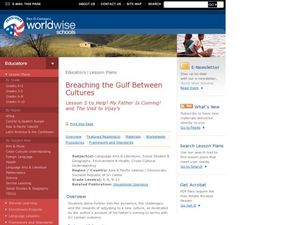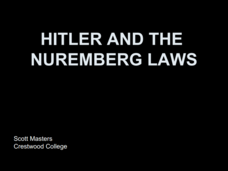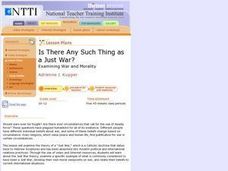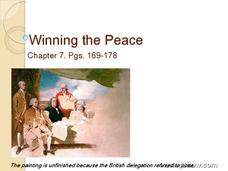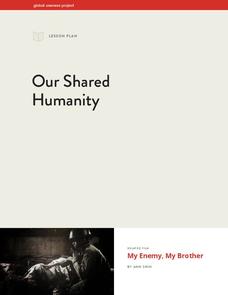Curated OER
Breaching the Gulf Between Cultures
Students read excerpts from Jim Toner's memoir Serendib which chronicles his experiences as a Peace Corps volunteer in Sri Lanka. They work in small groups to analyze the excerpts and discuss how the author came to terms with Sri Lankan...
Curated OER
Europe in Upheaval (1850 - 1914)
Europe was in a state of transition and upheaval that spanned a time of 60 years, beginning in 1850 and running through the first World War. Uncover the wars, key players, politics, and social movements that marked this time period in...
Curated OER
The Dropping of the Atomic Bomb at Hiroshima and Nagasaki
Take an in-depth look at the historical events in Hiroshima and Nagasaki in this 69-slide PowerPoint. Photos, facts, and transcripts are outlined in this presentation in order to answer the stated essential question in slide 2: "What...
Curated OER
Hitler and the Nuremberg Laws
Before you can really understand how WWII started, you need to understand the time prior to the rise of the Nazi Movement. Learn about Hitler as he grew up, rose through the military rank, and ultimately took charge of a nation. An...
DocsTeach
Cultural Diplomacy and the Smith-Mundt Act
During the Cold War, the United States used everything from bookmobiles to radio stations to improve its image globally. Using documents from the programs, including photographs and official memos, individuals consider how the United...
Curated OER
Who Started World War I?
Students debate which power was responsible for the outbreak of World War I. In this cause and effects activity, students research the causes of the outbreak of World War I on ProQuest in preparation for a (limited) reenactment of the...
Curated OER
Peace and Aggression: A Challenge of Our Time
Students examine the arguments for and against the United States involvement in the Vietnam War. In groups, they must assign the Vietnam War a just or unjust war using the techniques used to fight and the reasons used by the government...
Curated OER
A Separate Peace: Chapter 13 Reading And Study Guide
In this comprehension check worksheet, students define 3 vocabulary words, define 1 literary term, and respond to 6 short answer questions pertaining to chapter 13 of A Separate Peace by John Knowlesin order to help them better...
Curated OER
Peace and Perspective through Poetry: The Dream of Peace in the Middle East
Students use poetry to understand conflict in the Middle East. In this poetry lesson plan, students read persona poems and use the poetry and a novel as mentor text to guide their own poem about peace in the Middle East.
Curated OER
Is There Any Such Thing As A Just War?
Students examine the Just War theory, examine a specific example of what is commonly considered to have been a Just War, develop their own moral viewpoints on war, and relate their beliefs to current international situations.
Curated OER
World War I: War in a Democratic Society
Students research opposition and support for World War I from a number of perspectives. They analyze a number of primary and secondary sources, while considering what (if anything) makes a war just and write a letter expressing his/her...
Curated OER
America's Wars, 1898-1945
Students examine the wars the United States was involved in between 1898 and 1945. In groups, they determine the causes and effects of each war and how each war changed the way the United States handled their foreign affairs. As a class,...
Curated OER
The United States and the Soviet Union were Engaged in a Cold War
Students work together at figuring out the definition for what cold war means. In this social science instructional activity, students listen to "The Butter Battle Book" by Dr. Seuss and recognize how this story relates to the cold war...
Curated OER
Black Kentuckians and the Civil War
Students demonstrate how the American Civil War affected black Kentuckians socially and politically. They identify and discuss the 13th Amendment to the U.S. Constitution, which forced the end of slavery in Kentucky months after the...
Curated OER
War of 1812
Eighth graders locate the major land forms and bodies of water on a map of Louisiana. In groups, they discuss the role of the Mississippi River in the Battle of New Orleans and how land and water affect the outcome of battles. To end...
Curated OER
A Separate Peace
Tenth graders explore the novel, A Separate Peace by John Knowles. They discuss the events surrounding World War II and the events that were vital to progress during the war. Students locate New Hampshire on a map. They discuss the main...
Curated OER
The United Nations: Fifty Years of Keeping the Peace
Students examine the work of the United Nations. In this United Nations lesson, students listen to their instructor present a lecture regarding the history of the United Nations. Students respond to discussion questions pertaining to the...
National Endowment for the Humanities
Ending the War, 1783
The various peace proposals, made by both sides, to end the Revolutionary War come under scrutiny in this final lesson of a three-part series on the war. Class members read primary source documents and compare them with military...
Curated OER
The U.S. Involvement in the Paris Peace Conference: The Fate of Alsace-Lorraine
Tenth graders deliberate about what to do with the Alsace-Lorraine. In this World War I lesson, 10th graders analyze documents about the future of the Alsace-Lorraine at the Paris Peace Conference. Students collaborate to decide what to...
Power Show
Winning the Peace
There is a price for peace. The information and images contained in this 19-slide presentation illustrate the compromises necessary and the costs to those who backed the losing side in the battle for American independence.
Smithsonian Institution
Western Indian Wars
Why do many Native Americans live on reservations? An interactive resource teaches about how reservations came to be and the tragic history behind Native Americans moving from their lands. Teenagers read passages, view images, and click...
Global Oneness Project
Our Shared Humanity
Ann Shin's award-winning documentary, My Enemy, My Brother introduces viewers to Zahed Haftlang and Najah Aboud, two child soldiers on opposite sides during the Iran-Iraq war. After viewing the film, class members are asked to reflect on...
Curated OER
The Debate in the United States over the League of Nations: League of Nations Basics
High schoolers examine Woodrow Wilson's ideas for peace and the League of Nations. They examine how he garnered supported of it by looking at images and discussing their context.
Concordia University Chicago
Peace and Plenty by George Inness
Learners will need to discuss the Civil War to truly understand the painting Peace and Plenty by George Inness. They'll analyze the painting in terms of context, style, and technique. Then, they'll experiment with light and composition...
Other popular searches
- War and Peace Tolstoy
- 1980s War and Peace
- Drama War and Peace
- Russia War and Peace
- War and Peace Tplstoy
- War and Peace Activities
- World War I Peace
- Peace or War Songs


